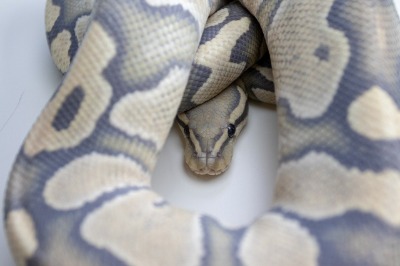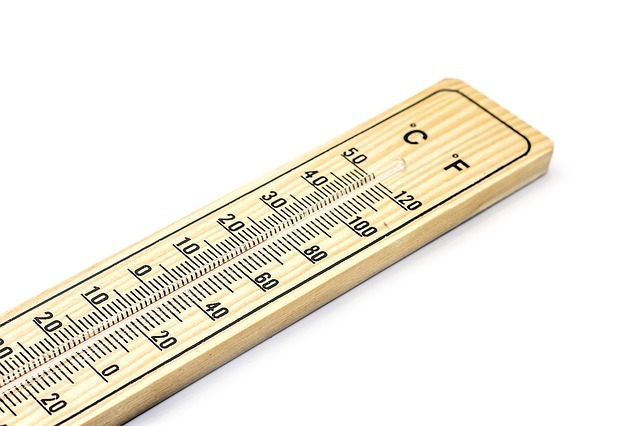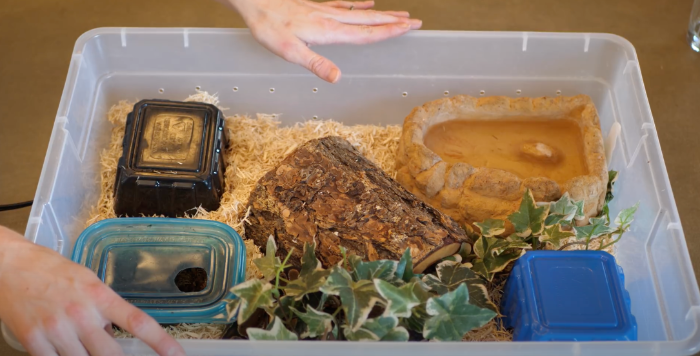Ball Python Care Guide
Hi, I'm Ethan, your guide to help you learn how to take care of your ball python. In this guide, we'll include diet, feeding, housing, normal behavior, signs of health and disease.

Learn How to Set Up Your Ball Python Cage
Emily from Snake Discover will be your guide to tell you what you need to make a ball python enclosure and how to take care of your first ball python. Watch this video to get ideas and keep reading below for more specifics on ball python care.
How to Feed a Ball Python : Diet Recommendations
Ball pythons are non venomous snakes that constrict their prey. Ideal foods include:
Fresh clean water at all times must be available in the cage. The dish should be large enough for the snake to soak in also.
Mice - Room Temperature thawed from frozen - DO NOT microwave or cook.
IF FEEDING LIVE RODENTS, DO NOT LEAVE UNATTENDED.
Frequency:
Feed an adult python 1 mouse every 1-2 weeks.
Juveniles should be fed once a week.
Safety:
Make sure to use tools that will not associate opening the cage and reaching in with getting fed. You may use a special tool to place the mouse in the cage.


Ball Python Behavior
Your snake will regularly shed its skin at it outgrows it. The eyes may appear to cloud over and the skin may dull. Your snake may appear more cranky or irritable. Avoid handling it through this time if possible.
As your snake sheds, make sure there is sufficient humidity in the cage. The entire skin should come off. If parts of it are stuck on the snake, they may create a problem if it persists.
Snakes shed every 4-12 weeks, depending on their size and growth rate.
Building a Safe Ball Python Cage Enclosure

Heat, Humidity and Fresh Air
Your ball python cage needs to have good air flow and properly regulated humidity and heated areas. It's important to keep your enclosure monitored with a thermometer, hygrometer for 40-60% hygrometer, and sufficient fresh air coming into the enclosure with lots of air holes.
The warm end should be 95 F degrees, the cool end 78 F degrees so that the python can regulate its temperature well.

Well Secured and Good Lighting
Whatever type of cage you have, make sure that the top has multiple latches on it that cannot be worked around. Pythons are very adept at working their way out of tight spaces so be sure that it is not accidentally left unlatched.
The enclosure should provide 8-12 hours of light per day. The lighting may contribute to the consistent temperature control.

The Right Size Cage & Substrate
A baby ball python needs at least a 20 liter enclosure. An adult needs up to at least a 40 gallon cage, ideally a minimum of 36" x 18" x 15".
Use mulch type, moss, or coconut fiber bedding can all work well to cushion your snake. Offer a hiding place like an empty log where the snake can retreat.
DO NOT house different snake species together.
SIGNS of a HEALTHY PYTHON
-
Shedding regularly and completely every 1-3 months
-
Active and alert, eats regularly
-
Clear eyes except when shedding
-
Skin free of mites and ticks
WARNING SIGNS of a SICK SNAKE
-
Excessive or scarce shedding or uneven skin
-
Not interested in eating or abnormal feces
-
Labored breathing or whiteness in mouth
If you notice any of these signs, contact your veterinarian.
Want to Find Your Next Ball Python?
Learn more about morphs and the best place to buy a ball python.